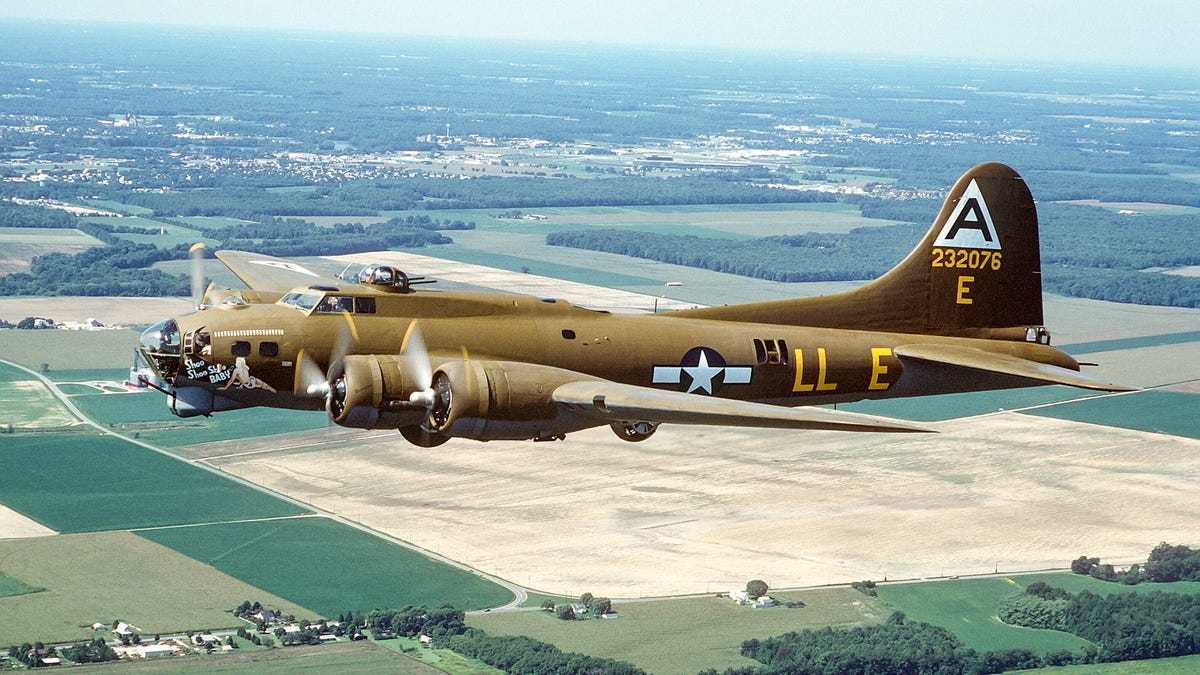 Why You Can Trust CNET
Why You Can Trust CNET WWII icon: A closer look at the legendary B-17 Flying Fortress
Few aircraft have captured the public's attention and admiration like the B-17. Crews loved it; movies and TV shows celebrated it. Here's a closer look at this incredible plane.

Over Europe during World War II, huge multi-engine warplanes crisscrossed the skies. British Lancaster and Halifax bombers, along with American B-24s and other warplanes, relentlessly pounded German factories and infrastructure.
One bomber, however, caught the imagination of a nation and has a lasting legacy as one of the icons of the war. It wasn't the biggest and it didn't carry the heaviest bombload, nor was it the most produced. But its rugged design protected its crews, while its defensive armament, once called a "porcupine in the sky," warded off enemy fighters. Traveling in vast combat box formations, they dropped hundreds of thousands of pounds of bombs on Nazi Germany.
It was, of course, the B-17 Flying Fortress. Here's a closer look.
Inauspicious beginnings
Boeing designed the iconic B-17 in the early 1930s. Though the prototype crashed on a flight in 1935, it performed well enough that the Army Air Corps (the forerunner to the US Air Force) wanted to see more and additional prototypes were built. It entered service in 1938, and more than 12,000 would eventually be built not only by Boeing, but also by Douglas and Lockheed under contract.
Like most WWII aircraft, the B-17 would see multiple updates to make it more effective. More guns, more powerful engines and subtle tweaks to the overall design. The most widely produced variant, the G, is easily recognizable by its chin turret, housing two .50-caliber machine guns for a total of 13. Depending on the mission requirements, the B-17 could carry between 4,500 and 8,000 pounds of bombs (2,000-3,600kg). Over a third of all the bombs dropped on Germany and its allies in the war fell from B-17s.
Lifting aloft the bombs, guns, and 10 crew members, were four Wright R-1820 Cyclone 9-cylinder radial engines. By the end of the war, these generated 1,200 horsepower each with the help of turbochargers. Maximum speed was 287 mph (462 km/h), but cruising speed was around 182 mph (293 km/h). Range depended on bombload, but was around 2,000 miles (3,219 km), enough for a roundtrip between airbases in Britain and Germany.
The war and beyond
Other allied bombers of WWII had better performance -- the Lancaster, for example, could carry a much greater bomb load and the B-24 was faster. What the B-17 became known for was an impressive durability. Its ability to return to base despite considerable damage became a thing of legend. In one famous photo a B-17 is shown returning to base despite having its tail almost completely shorn off after a midair collision with an enemy fighter.
Though the vast majority of B-17s were standard heavy bombers, most commonly of the F or G variants, there were a few prototypes and experimental models. The YB-40, for instance, was a heavy gunship version, featuring additional machine guns on its top, front and sides. It was meant to add additional firepower for escorting B-17s on missions in the years before fighters like the P-51 had the range to accompany bombers all the way to Germany from Britain and back. The XB-38 had more powerful Allison V12s engines, the same as those on the P-38 and P-51. The C-108 was a VIP/passenger transport variant, and was the personal aircraft of General Douglas MacArthur. These versions weren't successful. The B-17 was meant to be a bomber, and it was good at it.
During the war, thousands of men would fly thousands of missions in the B-17s all around the world. Many died, but many more lived. Factories, and entire cities, would be destroyed. Eventually, though, the Allies would, of course, prevail.
After the war, countless B-17s were scrapped, both because they were unneeded and obsolete compared to the newer B-29s and upcoming B-36. Some found their way into service in the private sector as water bombers, aerial survey aircraft and more.
The public's fondness for the aircraft lived on, largely thanks to Hollywood. Numerous TV shows and films would feature the B-17 both during and after the war, like 12 O'clock High and Memphis Belle.
Today, there are a few dozen B-17s left. Most, but not all, are aircraft that never saw combat. In museums around the world, most sit quietly, offering visitors a glimpse of aviation and world history. A few still fly. Their old radial engines sputter and roar to life, and the Fortress takes to the sky once again. Sometimes, sadly, with tragic results.
There are even a few opportunities for the average person to go inside and have a look around. "Miss Angela," at the Palm Springs Air Museum is one, as is "Piccadilly Lilly II" at the Planes of Fame Museum in Chino, California. The legendary "Memphis Belle" also survives, and is on display at the National Museum of the Air Force in Ohio.
Today, 85 years after its first flight, the B-17 lives on as an icon of American air power in World War II. Thanks to the tireless efforts of restoration teams around the world, the remaining airframes can inspire new generations of pilots-to-be of a time the world stood up against the rise of fascism. If you don't live near one of the many museums that houses a Flying Fortress, check out the gallery above for a closer look.
As well as covering audio and display tech, Geoff does photo tours of cool museums and locations around the world, including nuclear submarines, aircraft carriers, medieval castles, epic 10,000-mile road trips and more.
Also check out Budget Travel for Dummies, his travel book, and his bestselling sci-fi novel about city-size submarines. You can follow him on Instagram and YouTube.

